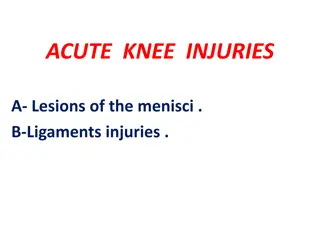Safe Lifting Techniques to Avoid Ergonomic Injuries: A Comprehensive Guide
Ergonomic injuries are a significant concern in the workplace, with musculoskeletal disorders being a common result. This tutorial explores the risks faced by movers/material handlers and provides insights into safe lifting techniques to prevent injuries. Understanding the importance of ergonomics in fitting work to the worker can significantly reduce the chances of musculoskeletal/cumulative trauma disorders. Recognizing the symptoms of these disorders and the benefits of integrating ergonomic interventions are key steps in promoting a healthy and safe work environment.
Download Presentation

Please find below an Image/Link to download the presentation.
The content on the website is provided AS IS for your information and personal use only. It may not be sold, licensed, or shared on other websites without obtaining consent from the author.If you encounter any issues during the download, it is possible that the publisher has removed the file from their server.
You are allowed to download the files provided on this website for personal or commercial use, subject to the condition that they are used lawfully. All files are the property of their respective owners.
The content on the website is provided AS IS for your information and personal use only. It may not be sold, licensed, or shared on other websites without obtaining consent from the author.
E N D
Presentation Transcript
Safe Lifting techniques to avoid injury Ergonomic injuries account for 35% of all worker s compensation injuries in the United States. The goal of this tutorial is to identify injuries common to movers/material handlers and to explore various safe lifting techniques.
Ergonomics is fitting the work to the worker Ergonomics is about fit . The fit between a person and what they do, the objects they use and the environments in which they work. If good fit is achieved, the stresses on people are reduced. They become comfortable, can do things efficiently and productively without discomfort. Exposure to more than one risk factor increases the chances of experiencing discomfort. An ergonomic evaluator will look for specific risk factors that may indicate a poor fit, and then make recommendations to reduce these risks which without resolution, could lead to a musculoskeletal/cumulative trauma disorder
What are musculoskeletal/cumulative trauma disorders? A musculoskeletal disorder is discomfort of the muscles, ligaments, tendons, joints or nerves which could include strain, sprain or inflammation which typically accumulates over time. They are NOT a diagnosis, but a class of disorders with similar characteristics. Microtrauma experienced by the body on a daily basis can heal over time. But if we experience more trauma than the natural healing process can absorb, the result is a MSD/CT injury
Symptoms of musculoskeletal disorders Symptom Description or observation Pain sharp, shooting or dull Most common symptom which may be present at rest or while using the injured body part Tenderness The part may be sensitive to the touch Heat or burning The body part may feel warmer than normal or even feel hot Tingling and/or numbness You may feel partial or intermittent tingling or some numbness over the injured area Cramping or spasm The muscles may remain in a cramped state or the muscle may suddenly and involuntarily contract Clumsiness or weakness You may find you are dropping things more frequently or things that were easy to hold previously are heavy to you now
Why even bother with ergonomics? Pre-pandemic study(2018) in the US found that ergonomic improvements resulted in: 75% reduction in lost workdays 48% decrease in turnover CDC study(2015) found cost associated with lost productivity due to back pain $1,685 per case MSD/CT Injuries can be controlled through ergonomic interventions
Ergonomic Risk Factors These 6 ergonomic risk factors should be avoided whenever possible. Note that many situations will expose you to more than one risk factor at a time. .
Because Musculoskeletal disorders develop over time, there are ways to reduce injury risk 1. Change the way you do your work 2. Use equipment 3. Change the environment Let s discuss these three ways to reduce injuries
Change how you work: Injuries can occur by: Lifiting and twisting at the same time
Change how you work: Injuries can occur by: Lifting bulky or odd shaped objects
Change how you work: Injuries can occur by: Bending at the waist and lifting at the same time
Change how you work: There are many safe ways to lift a load
Change how you work: Injuries can occur by: Lifting and reaching for an object that is too high Don t Lift heavy objects from overhead Do raise yourself to be closer to the load
Change how you work: Injuries can occur by: Pulling instead of pushing Don t pull a load when you can push it Do push a load, even a handcart
Change how you work: Injuries can occur by: Lifting a load that is too heavy
Change how you work: Use Equipment
Change how you work: Change your environment Reorient supplies on shelves to allow heaviest items between knee and waist height, lightest items on top Dumpsters with windows instead of lifting lid to dispose of trash
Back Belts good or bad? NIOSH reports there is no compelling evidence that back belts prevent back injury or back pain.
Summary Musculoskeletal Injury risk can be reduced with work method change, equipment use and environmental changes. Don t be a statistic, think before you work and work smarter, not harder.
If you are not sure what you need, contact EHS ergonomics EHSErgonomics@umich.edu
Ergonomic Sarah Cooney, OTR/L Senior Ergonomics Professional University of Michigan Environment, Health and Safety scooney@umich.edu 734-763-7704 EHSErgonomics@umich.edu























